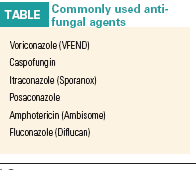Prophylaxis fends off life-threatening invasive fungal infections
Candida and Aspergillus are the most common causes of invasive fungal infections in immunocompromised patients. Over the past two decades, there has been a substantial rise among cancer patients in the incidence of life-threatening invasive fungal infections that pose significant clinical challenges for the oncology community (N Engl J Med 348:1546-1554, 2003).
ABSTRACT: Invasive fungal infection carries a mortality rate ranging from 50% to 90% in certain patients. Infectious disease experts explain why offense in treatment is the best defense.
Candida and Aspergillus are the most common causes of invasive fungal infections in immunocompromised patients. Over the past two decades, there has been a substantial rise among cancer patients in the incidence of life-threatening invasive fungal infections that pose significant clinical challenges for the oncology community (N Engl J Med 348:1546-1554, 2003).
Brahm H. Segal, MD, chief of infectious diseases at Roswell Park Cancer Institute in Buffalo, N.Y., explained that the increased incidence of IFIs correlates with today’s growing high-risk patient population.

“We now have significantly more stem cell and solid organ transplant recipients and greater numbers of patients receiving intensive chemotherapy for acute leukemia,” Dr. Segal told Oncology News International.
“Candidiasis, which can present with a spectrum of diseases from mucosal infection to disseminated and invasive disease, is the central IFI caused by endogenous flora that have colonized in the gastrointestinal tract,” Dr. Segal added.
Major risk factors for candidal infections include neutropenia, mucositis, use of broad-spectrum antibiotics, chemo-induced immune dysfunction, GI surgery, indwelling catheters, and total parenteral nutrition.
“Aspergillus and other mold infections are generally contracted from environmental exposure, inhalation of airborne spores,” continued Dr. Segal. Aspergillus and other mold infections pose a greater threat than invasive candidiasis in patients with acute leukemia and allogeneic hematopoietic stem cell transplantation when prophylaxis with fluconazole (an agent active against yeasts but not molds) is used, he explained.
Understanding how IFIs can be acquired requires clear review of both endogenous and environmental sources leading to transmission of these infections. In-patient environmental exposure has a well-documented association with Aspergillus infection; in fact, molecular testing of fungal strains from patients and their corresponding hospital environment has found that perhaps 40% of cases of invasive aspergillosis are nosocomial (Clin Microbiol Infect 12[Supplement 7]:77-83, 2006).
Up to 90% of invasive aspergillosis presents with pneumonia; inhalation of Aspergillus spores is presumed to be the causative agent in this syndrome. High-efficiency particulate air (HEPA) filters have been shown to reduce the number of airborne spores and the incidence of invasive aspergillosis. However, studies show that HEPA filters do not completely eliminate risk of infections, which suggests exposure from alternate sources such as in-hospital water systems. Construction, ventilation and air-conditioning systems, flower arrangements, dust, carpets, and computer fans are also potential sources of environmental-related transmission of aspergilli, especially in an outpatient setting.
Empirical treatment varies
Populations at high risk for fungal infections require diagnostic approaches, such as radiologic imaging, culture, and histopathology of fluids or tissue biopsies. “There have also been novel advances in early diagnostic methods of invasive fungal infections, which include galactomannan and β-glucan antigen detection and polymerase chain reaction using fungal-specific primers,” said Dr. Segal. Polymerase chain reaction-based diagnosis of IFIs is promising, but still considered investigational.
Three lipid formulations of amphotericin B are now available for treating invasive fungal infections: amphotericin B lipid complex, amphotericin B cholesteryl sulfate, and liposomal amphotericin B. However, despite the availability of emerging antifungal drugs, the overall mortality in immunocompromised patients remains high, with large variations according to underlying disease.
Because diagnosing a fungal infection is difficult to establish with certainty, antifungal prophylaxis is increasingly being used to prevent these infections. But, according to Michael G. Ison, MD, “Many of the medicines used to prevent fungal infections reduce the incidence of these pathogens, but-with the exception of posaconazole and a subset of situations and patients-they haven’t been shown to markedly reduce mortality.”

Dr. Ison noted that prophylactic measures reduce hospitalizations and lengths of stays, and in that way, they add to patients’ quality of life and reduce healthcare costs. Dr. Ison is director of the transplant and immunocompromised host infectious diseases service at Chicago’s Feinberg School of Medicine at Northwestern University.
Prevention needed
Regardless of where the infection is acquired, preventing invasive aspergillosis requires novel approaches, such as the use of antifungal prophylaxis in high-risk patients. Although Aspergillus and other molds are ubiquitous in the air, the spores can produce deadly diseases when inhaled by susceptible hosts.
One-third of invasive aspergillosis cases occur in bone marrow transplant recipients, and more than one-quarter occur in cancer patients with hematologic malignancies. The Centers for Disease Control and Prevention (CDC) and the Healthcare Infection Control Practices Advisory Committee (HICPAC) advise practitioners to adhere to appropriate guidelines for environmental infection control within healthcare facilities. Both groups have published online guidelines.
Studies look at prophylaxis
Major organizations such as NCCN, the Infectious Diseases Society of America (IDSA), and the European Conference on Infections in Leukemia recommend using prophylactic measures in high-risk patients, according to Oliver Cornely, MD, from the University of Cologne in Germany.
Dr. Cornely participated in one of two landmark clinical studies on infections caused by Aspergillus and Candida. He told Oncology News International that high-risk patients who develop IFIs have a mortality rate ranging from 50% to 90%. “Thus, because a delay in treatment greatly increases the risk of mortality, prophylaxis is commonly used as a therapeutic strategy,” Dr. Cornely said.
In the two studies, the investigators enrolled more than 1,200 subjects, including hematopoietic stem cell transplant (HSCT) recipients with graft-vs-host disease (GVHD); patients with acute myelogenous leukemia (AML); and patients with myelodysplastic syndromes (MDS) with prolonged neutropenia from chemotherapy.
One of the studies, which was led by Dr. Cornely, was a randomized multicenter open-label trial comparing posaconazole (200 mg three times daily) with fluconazole (Diflucan [400 mg once daily]) or itraconazole (Sporanox [200 mg twice daily]) as prophylaxis against IFIs in neutropenic patients receiving chemotherapy for AML or MDS. Posaconazole demonstrated a reduction in proven and probable IFIs, which was the primary study endpoint (2% vs 8%); significantly fewer breakthrough Aspergillus infections (1% vs 7%); and improved overall survival (N Engl J Med 356:348-359, 2007).
The cumulative data from this study and one led by Andrew J. Ullmann, MD, revealed substantially fewer breakthrough infections in those high-risk patients receiving posaconazole compared with those who received the combined comparator drugs fluconazole or itraconazole (N Engl J Med 356:335-347, 2007). “With posaconazole, we now can help prevent infections caused by the two most common pathogens, Aspergillus and Candida, before they occur,” Dr. Cornely said.
Treatment costs
Given the burgeoning budgetary issues faced by healthcare systems, cost is always a concern. But Dr. Cornely said that in most cases, “prophylaxis is expected to be cost-effective.” Although there have been few examinations of the cost-effectiveness of IFI prophylaxis, a 2005 study led by Joseph Menzin, PhD, at Boston Health Economics, found that head and neck cancer patients with IFIs had significantly higher mortality rates than their counterparts without IFIs (40% vs 14%); longer hospital stays (20 days vs 9 days); and higher Medicare payments at $34,268 for those who did not receive IFI prophylaxis compared with $21,416 for those who did (Value Health 8:140-148, 2005).
A more recent dollars-and-cents analysis of IFIs found that posaconazole prophylaxis could be more cost-effective compared with fluconazole/itraconazole in neutropenic AML/MDS patients after intensive chemotherapy. The investigators from Mapi Values in Houten, the Netherlands, calculated that the total cost (treatment of breakthrough IFI plus prophylaxis) for posaconazole was €183 less than the €4595 price tag associated with standard azoles (Eur J Haematol 81:467-74, 2008).
An Australian study, which was presented at the 2008 Interscience Conference on Antimicrobial Agents and Chemotherapy and Infectious Diseases Society of America meeting, determined that the mean costs associated with treating infection was AU$302,563 per IFI and AU$64,911 per control with pharmacy costs dominant and composing 52% of the difference (abstract M-737). However, another poster noted that the costs associated with treatment can be equally as hefty. A French group performed a retrospective chart review on AML patients presenting with probable or proven IFI to study the resources consumed, and costs associated, with these infections.
They determined that the mean total cost of IFI episodes was estimated at €35,967 for the costs of antifungal treatments, €13,721 for additional charge for index hospitalizations, and €1,345 for additional hospitalizations, leading to a total average cost per case of €51,033 (ICAAC/IDSA abstract M-736).
Perhaps the type of antifungal agent used can make a difference (see Table, p. 12). A recent cost analysis of IFI found that posaconazole prophylaxis could be more cost-effective compared with fluconazole/itraconazole in neutropenic AML/MDS patients after intensive chemotherapy. The investigators from Mapi Values in Houten, the Netherlands, calculated that the total cost (treatment of breakthrough IFI plus prophylaxis) for posaconazole was €183 less than the €4,595 price tag associated with standard azoles (Eur J Haematol 81:467-74, 2008). “Recent analyses of antifungal prophylaxis suggest that treatment falls within the internationally accepted cost-effectiveness thresholds,” Dr. Cornely said.
Newsletter
Stay up to date on recent advances in the multidisciplinary approach to cancer.